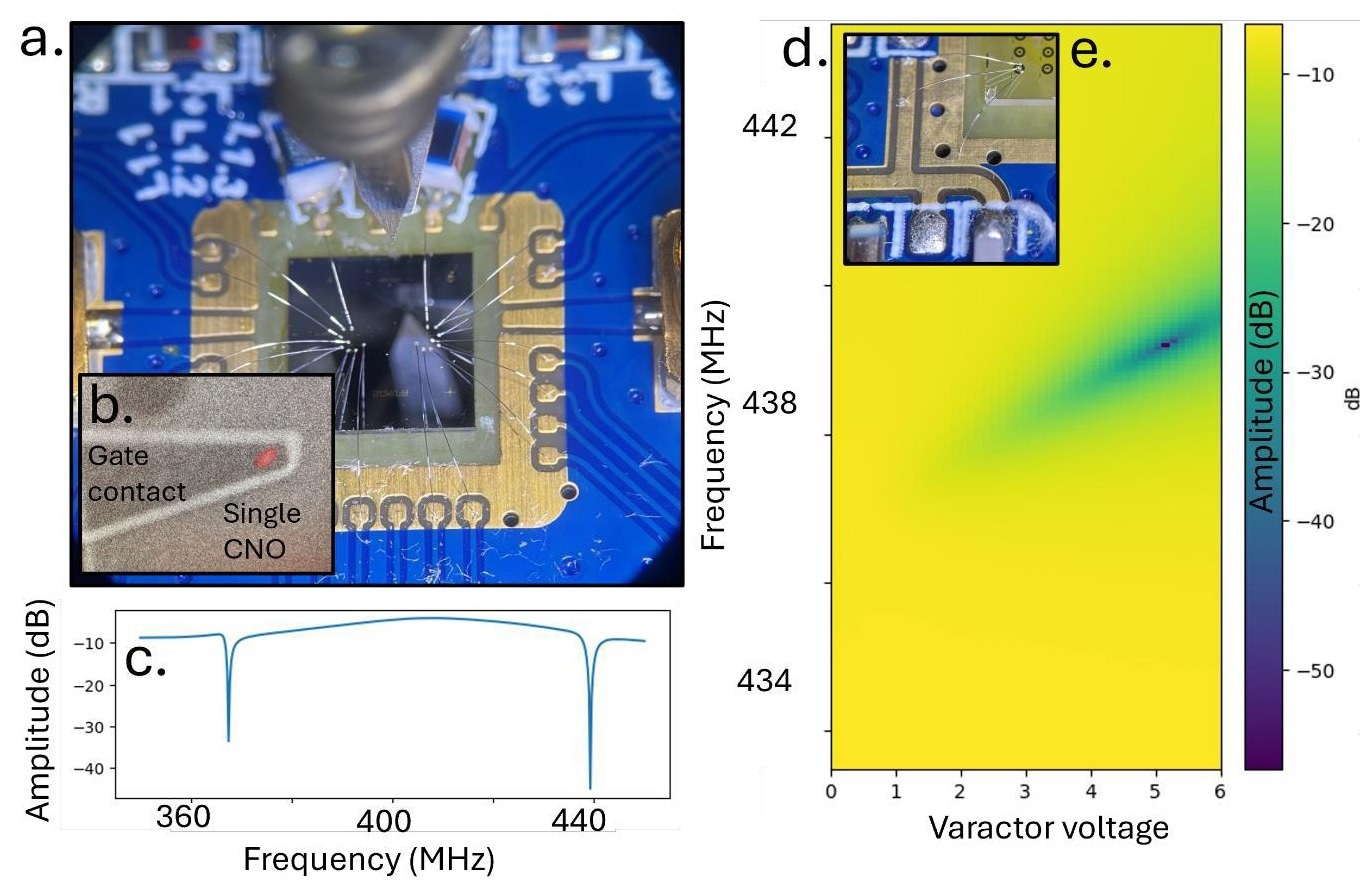Archer Materials Limited, a semiconductor company advancing the quantum technology and medical diagnostics industries, provides an update on recent developments and progress with its quantum computing 12CQ Project, including achieving longer electron spin lifetimes and improving the accuracy and speed of quantum information readings.
 The company’s new method to enhance the accuracy and speed of readings quantum information using resonators to improve the ability to detect a single electron spin detection in the CNO material. (a) and (d) shows a test chip ready for testing with a high magnification image of a single CNO in a device (b). (c) and (e) show typical data collected from devices. Image Credit: Archer
The company’s new method to enhance the accuracy and speed of readings quantum information using resonators to improve the ability to detect a single electron spin detection in the CNO material. (a) and (d) shows a test chip ready for testing with a high magnification image of a single CNO in a device (b). (c) and (e) show typical data collected from devices. Image Credit: Archer
Advancing Single Electron Spin Detection
The Archer quantum team, led by Dr Simon Ruffell and Dr Byron Villis, has improved how the Company detects single electron spins. Archer has developed a new method using resonators that can be adjusted to how they respond to a spin signal. This means Archer can now fine-tune the resonators to make its readings faster and more accurate.
Adjustable resonator responses allow the Company to handle more quantum bits (qubits) at once. An electron’s ability to stay in a spin state depends on its stability and spin lifetime. Being able to read these signals faster means that more can be done with the electron before it loses its spin state.
The team conducted measurements over three separate test sessions. Each session refined the detection circuits, studying the characteristics of single electron box devices in different settings. As a result, Archer can more effectively read the quantum states of the materials used in these devices.
These resonator devices, along with development of the spin reading, build on the previous work for the pulsed electron spin resonance (“p-ESR”) chip, done in partnership with EPFL, and will lead to probing the spin on single CNOs.
The single electron box devices are made with extreme precision at the nanometre scale, each containing a single carbon nanoparticle. Devices worked well with standard gold nanoparticles, whereas those made with CNOs resisted electricity, and did not show stable single electron charging signal. The Archer team is now improving how the electrodes connect to CNOs, how electrons move through the CNOs, the number of electrons (spins) on our current CNOs, and the chemical makeup and size of the CNOs.
The team also achieved electron spin lifetimes of up to 300 nanoseconds of films of CNOs formed by a new process. These lifetimes match those measured on the pyrolysis method that was previously used for formation and pave the way for a manufacturable process of devices based on CNOs.
Exploring Electron Behaviour with QMUL
In late June, Archer commenced an official project with Queen Mary University of London (QMUL) to study electron movement through CNOs using graphene-based nanodevices, to observe the Coulomb blockade phenomenon, an important phenomenon in quantum physics. The collaboration officially began on 20 June 2024, focusing on detailed studies of initial test wafer properties.
Wafer measurements will be performed at a very low temperature of 77 Kelvin (-196 degrees Celsius), and the graphene electrodes on essential devices will be physically examined. The team will also check to confirm the presence of CNOs and clusters of CNOs on these devices.
Later this month, the team will meet with QMUL to discuss results from these colder temperature measurements on the test wafer. The Company will also review progress and data from devices specially made for and decorated with Archer's CNOs and sent to QMUL. This research is an essential step in Archer’s collaboration to understand how electrons behave in these unique materials.
The Company will provide regular updates on the work with QMUL.
Commenting on the progress by the Quantum team, Greg English, Executive Chair of Archer, said, “The Archer team has developed a new method to improve the detection of single electron spins using resonators. These resonators can be fine-tuned for faster and more accurate readings, a critical advancement for handling more qubits.
“Our quantum team, led by Dr Simon Ruffell and Dr Byron Villis, has achieved a lot during the past few months, and we look forward to updating the market on the results of our work with QMUL.
“Archer’s research is ongoing as it aims to enhance its devices and progress toward practical quantum computing applications.”